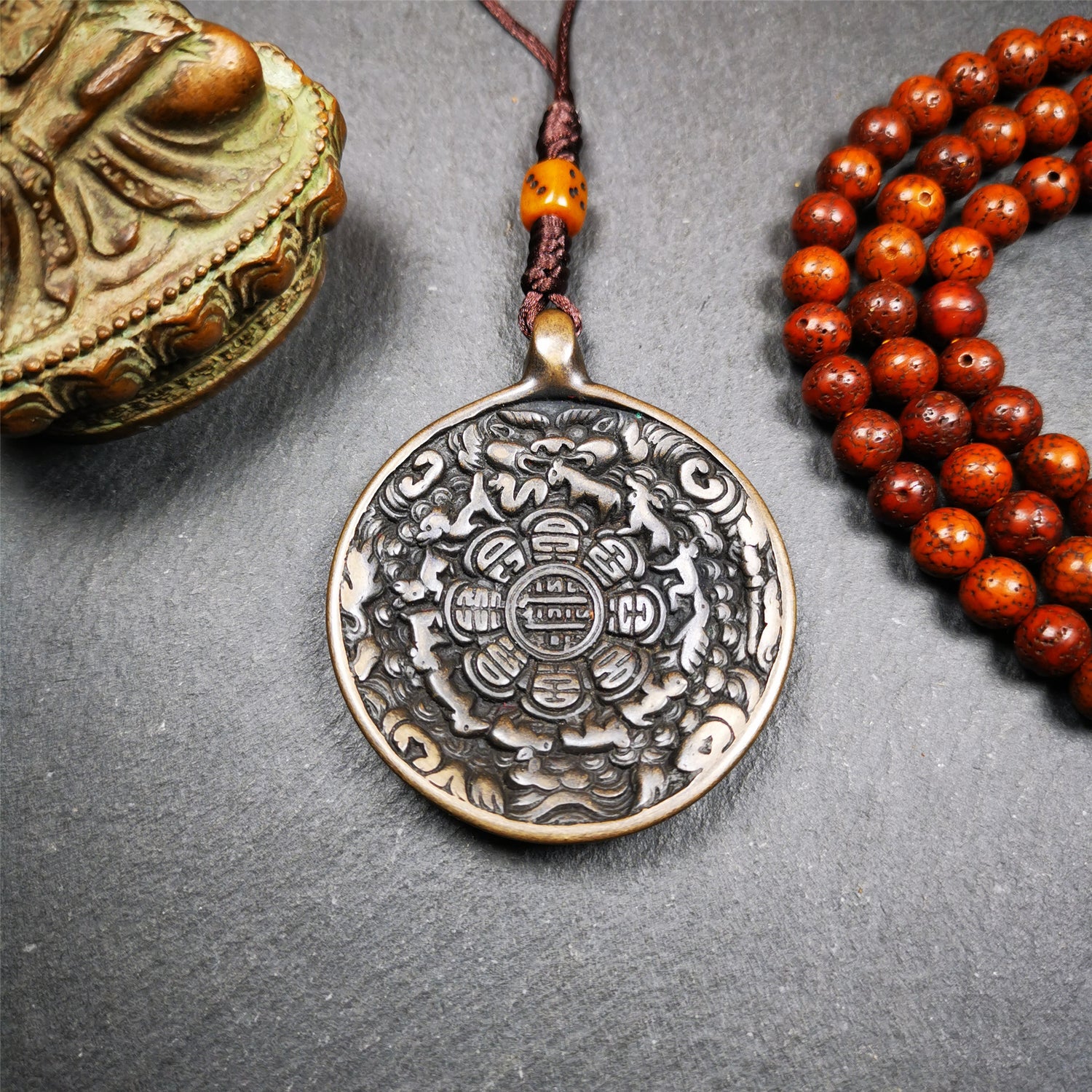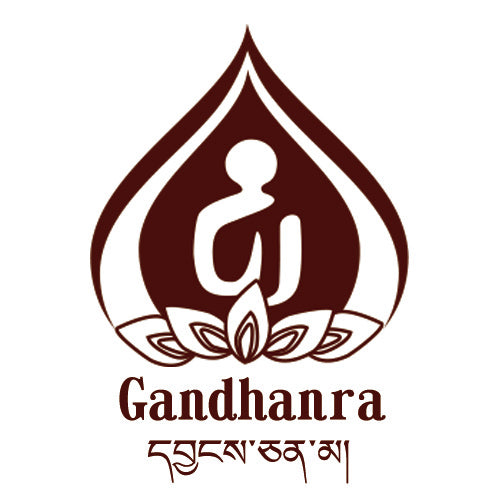1
/
of
10
Gandhanra Antique Tibetan Amulet,Kartika(knife of the dakinis), Trantic Buddhism Dharma, Made of Cold Iron
Gandhanra Antique Tibetan Amulet,Kartika(knife of the dakinis), Trantic Buddhism Dharma, Made of Cold Iron
⏱Vintage:
☞Handmade:
⚒Materials:
☲Size:
Regular price
$49.99 USD
Regular price
Sale price
$49.99 USD
Unit price
/
per
Couldn't load pickup availability
❤This unique kartika pendant is hand carved by Tibetan craftsmen from Tibet in 2000's.
From Hepo Town, Baiyu County, the birthplace of the famous Tibetan handicrafts.
Its upper part is a skull, and the lower part is a kartika,the symbol of the vine is inlaid with brass wire.
You can make it into a necklace, or a keychain, or just put it on your desk,as an ornament.
❤All our crafts are directly handmade from Tibet.
When you purchase this craft it helps and support the artisan and their families in Tibet.
Your support is highly appreciated.
❤Details
100% Handmade
Material:cold iron,brass
Pattern: kartika,knife of the dakinis. Dhrama
Height: 37mm /1.46 inches
Width: 18mm/ 0.7inches
❤ABOUT KARTIKA
A kartika (Sanskrit: kartari; Tibetan: གྲི་གུག་, Wylie: gri-gug,or kartrika in Nepal,) is a small, crescent-shaped, hand-held ritual flaying knife used in the tantric ceremonies of Vajrayana Buddhism. The kartari is said to be "one of the quintessential attributes of the wrathful Tantric deities."It is commonly known as the "knife of the dakinis."Its shape is similar to the Inuit ulu or woman's knife, which is used for many things including cleaning skins.
While the kartari is normally held in the right hand of a dakini in Vajrayana iconography and spiritual practice, occasionally it can be seen being held by esoteric male deities,such as certain forms of Yamantaka.It is also found frequently in the iconography of the Tibetan Buddhist spiritual practice of Chöd.
The dakini's knife has a flat sharpened blue iron blade with a curved hook at its outer extremity, which enables the flaying activities of cutting, scraping, and pulling. Its faceted or eight-sided handle is attached to the upper edge of the blade by either a leaf-shaped golden mount or the wide-open mouth of a golden makara, and the handle's top is sealed by a half-vajra.
The same way that the bell and vajra are usually paired ritual items in Vajrayana spiritual practice and iconography (one is held in the right hand and the other simultaneously held in the left), the kartika usually appears as a pair with the kapala or "skull-cup".
The shape of the kartika, or trigug, with its crescent shape and the hook on the end, is derived from the shape of a traditional shape of the Indian butcher's knife.
Depictions of Vajrayogini typically contain the kartika as one of her attributes. In the iconography of the enlightened dakinis and tantric female yidams, it is common to find the hooked kartika knife in her right hand and the skull cup in her left, representing "the inseparable union of wisdom and skillful means."
❤Meanings
The traditional interpretation of the hook in Tibetan Buddhist imagery is that of the hook of compassion. It is the hook which pulls beings out of the cycles of transmigration. The hooked crescent-shaped knife of the dakini with its vajra handle pulls one forth from suffering, chops up the ego-centred self and is guided by the diamond clarity of the vajra.
The kartika is used to symbolize the severance of all material and worldly bonds and is often crowned with a vajra, which is said to destroy ignorance, and thus leading to enlightenment. Another more nuanced interpretation says that "the kartika represents the severing of the two Buddhist obscurations of defilements (klesha avarana) and knowledge (jneya avarana) that obstruct the path of enlightenment." The kartika is also used to cut through human obscurations to progress on the spiritual path including "pride, lack of belief, lack of devotion, distraction, inattention, and boredom."
❤About śmaśāna-adhipati
In Tibetan Buddhism, the corpse lord Jinliila is the incarnation and protector of Victory Vajra and Vajra Yoga Dakinis, and is one of the nine protectors of the three roots of Nyingmapa (guru, dakini, and protector).
He governs the "Eight Great Cold Forests" where the corpse is abandoned and protects those who practice uncleanness in the corpse forest. According to legend, the Eight Great Cold Forests are the places where the lotus born to form the eight great Heruka deities, namely the tyrannical cold forest in the east and the cold cold in the north. Forest, the West King Kong Flame Cold Forest, the South Bone Lock Cold Forest, the Northeast Crazy Laughing Cold Forest, the Southeast Auspicious Cold Forest, the Southwest Dark Forest, and the Northwest Chirp Cold Forest.
The Tibetan Buddhist Tripitaka Tantra records that the corpse forest master lives in the corpse city of skeletons. There is a corpse forest skull palace and a lotus flower sun wheel seat in the city. The corpse forest owner and his wife stand hugging and standing on the seat cushion. The corpse lord in the thangka is usually shown as two white skeletons standing in an embrace, with five skull crowns (that is, five small skulls) on top of their heads, in the midst of raging flames of prajna, waving bone rods, aquariums, etc.; using skulls to express impermanence Emptiness, the horrific appearance of the skull destroys hatred.
❤Packaging &Shipping:
As per our Product nature, we do the packaging. For every single product, we do the bubble wrapping along with the paper carton boxes is also used for more safety. In the case of heavy products, we also use wooden boxes too for more safe packaging and sent for the shipping process.
❤Feedback:
Our goal is to make sure my customer is happy and satisfied when you shopping with us. Please contact or email before leaving negative feedback.
We will try out best to solve our issues. Please give us the chance to resolve any problem.
❤Notice:
1.Please allow 1-2mm error due to manual measurement.
2.Please make sure you do not mind before you bid.
3.The color may have different as the difference display, Please understand.
THANK YOU FOR purchasing our product.
View full details





















